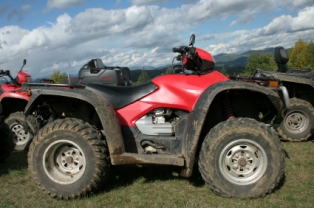All terrain vehicles (ATVs, also known as quad bikes) are one piece of farm equipment that most farmers can’t do without. Although they are not designed to be a tractor, on most small farms they can reduce the need for one.
ATVs are capable of a variety of farming tasks, including transporting people and equipment from A to B, towing a trailer, spraying, spreading and much more. For those that don’t know anything about motorbikes, selecting a hobby farm ATV can be a daunting task.
Buy a new or used ATV?
The decision whether to buy a new or used quad bike, as well as choice of model, make and size of the bike required will depend on your budget and on your reasons for buying a quad bike (e.g. for fun, transport or farm workhorse).
Used quad bikes range from $800 to $5,000 while new bikes cost anywhere from $4,000 to $19,000. Buying a used bike comes with the same associated risks as buying any piece of used farm equipment.
If a used bike is your preference, you should check the oil dipstick and for metal fragments (which indicates motor wear). You should also investigate the regularity of its oil/filter changes and check that these are detailed in the service book. Finally, ensure the bike is not subject to finance and don’t forget to take it for a good test ride.
Engine and transmission
Assessing the engine and transmission of a quad bike is important. You need to ensure there is enough grunt for farm work. Bike engines are powered by either a single or twin cylinder with engine sizes ranging from 150 to 800 cubic centimetres (cc). The larger the cc, the faster and more powerful the bike. Engines are either liquid cooled by a radiator or air cooled by air flowing over and cooling the cylinder. Air cooled quad bikes are generally cheaper, lighter and simpler than liquid cooled bikes.
Most ATV transmissions are five-speed complete with high and low range, neutral, reverse and park features. Two-wheel drive is normally standard with four-wheel drive an option.

Rider comfort and quality
If you plan to use your quad bike regularly, a thick padded, well-moulded seat is a must have. Rough and rocky terrain will require independent coil suspension to increase rider comfort. Only the top of the line models come with power steering.
Brakes and tyres
Good ATV brakes are essential if you plan to be negotiating steep and slippery slopes. Brakes come in hydraulic disc or padded forms, operating either single (front and back wheels braking independently) or dual braking (front and back simultaneously). Brakes are either foot or handlebar operated. A handlebar operated brake has the added benefit of operating as a park brake.
Bike tyres come in 2, 4 and 6 ply, the higher the number the increased durability of the tyre. Check the tyre ply before purchase as many new bikes come with only 2 ply tyres.
Load and tow
A farm ATV will require plenty of carrying capacity, including front and rear racks. Front racks can carry from 25-50kg and rear racks from 50-100kg. If you plan to tow a trailer, spray unit or spreader, your bike will require a tow bar and ball. Maximum towing capacity on the largest ATVs is approximately 450kg.
Rider safety
Rider safety should be an important consideration when purchasing a farm ATV. They were the leading cause of serious farm injury and death during 2011. While rider education and training have an important role to play, the use of rider helmets and the attachment of a crush protection roll bar device can significantly reduce the likelihood of injuries or death.
Bike protection
Most ATVs come with standard protection devices including handlebar protectors and bash plates on the undercarriage of the bike. If you plan to be working in rugged terrain with obstacles, select a bike with a high under frame clearance.
Other ATV features
Most farm ATVs come standard with a liquid crystal display (LCD) featuring the fuel level, time, engine temperature, warning lights and 2WD or 4WD selection. Other add-ons may include a winch, which is typically located on the front of the bike and can be useful if you are operating it by yourself in an i isolated area.
Where limited public road access is required, primary producer conditional registration can be obtained. For this type of registration, the bike will require indicators, lights, brake lights, rear reflectors, rear view mirrors and a horn. Some models straight out of the box will be registrable whilst others will need these features added.
Warranty and parts
A two-year warranty is standard, with top of the line brands often offering extended warranty periods. Prior to purchase, check with your local dealer that spare parts are readily available. The last thing you want is to break down and have to wait weeks to get the bike fixed.
Where to from here?
For further information on ATVs we recommend you purchase a copy of ATV-Agskills. This book shows how to use an ATV safely, including riding on slopes and in sand, water and mud.
About the author
The author Charlie Roberts is one of the FarmStyle Australia experts, he has a Bachelor of Farm Management and a Masters of Business Administration. He has worked for a number of agricultural companies in both New Zealand and Australia and has a wealth of experience working with farmers in a range of environments.


